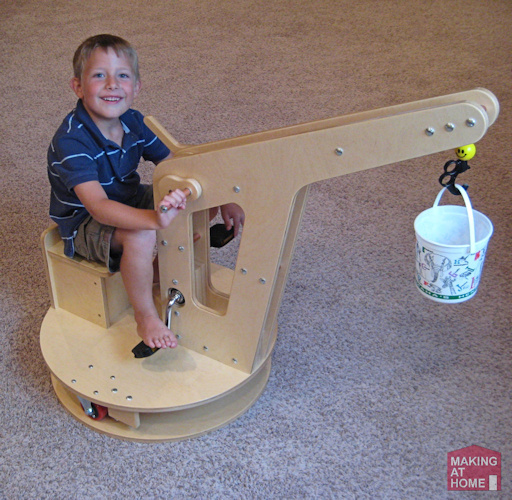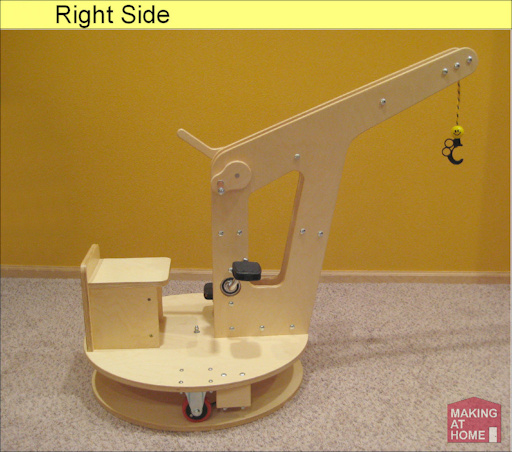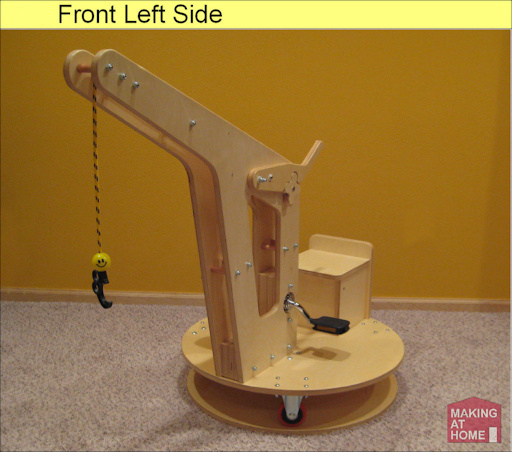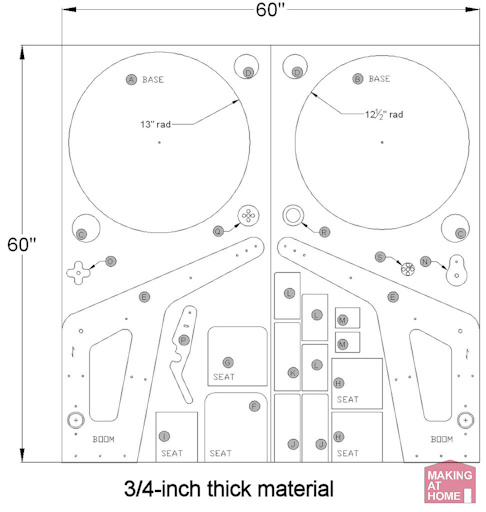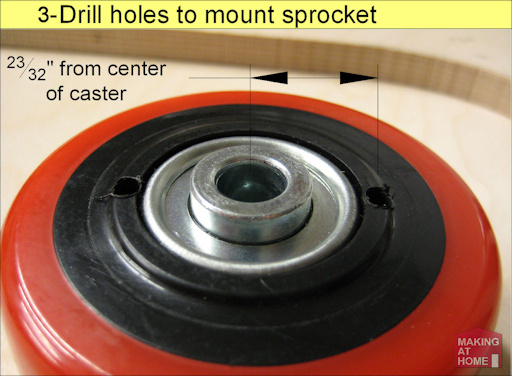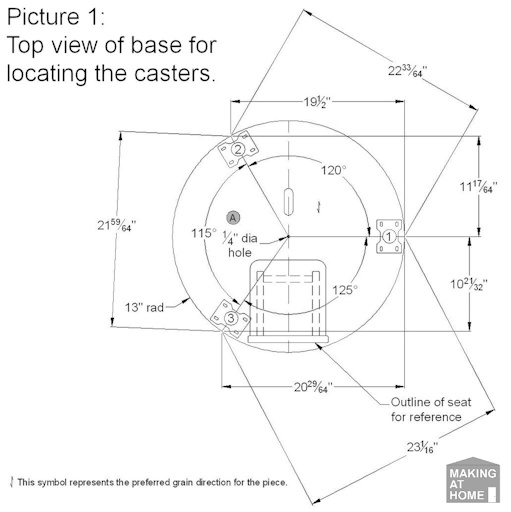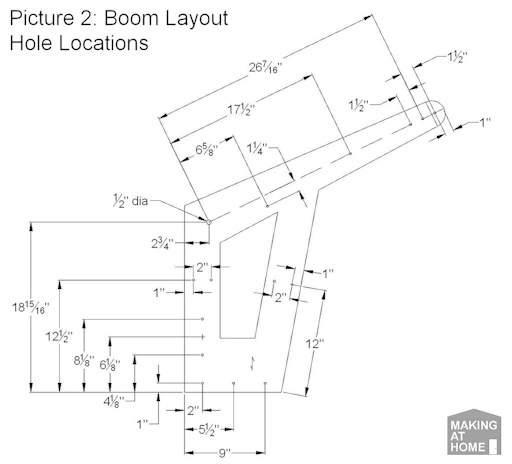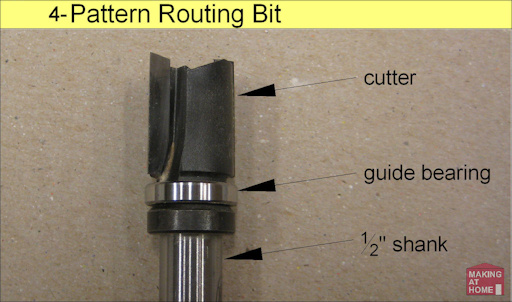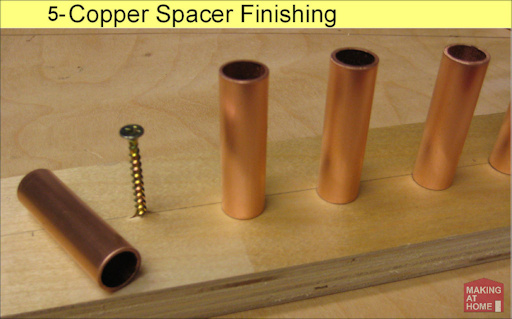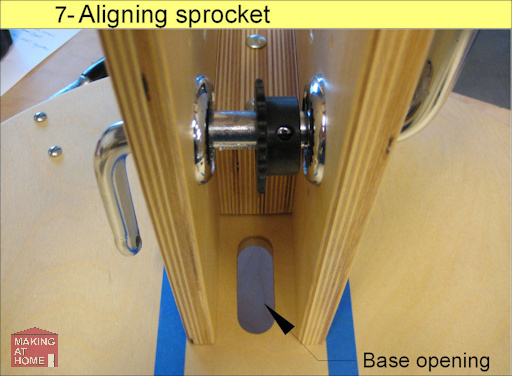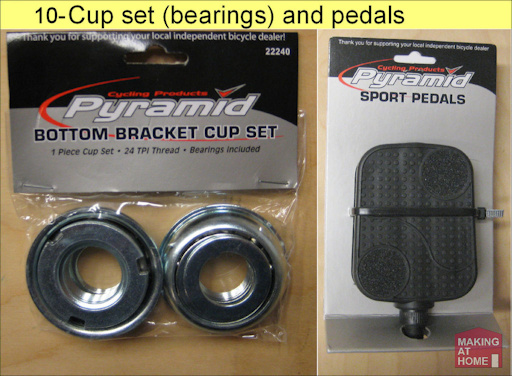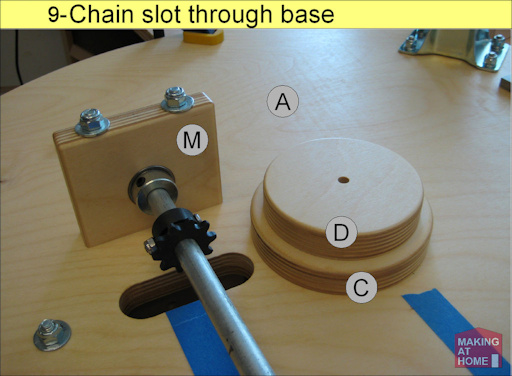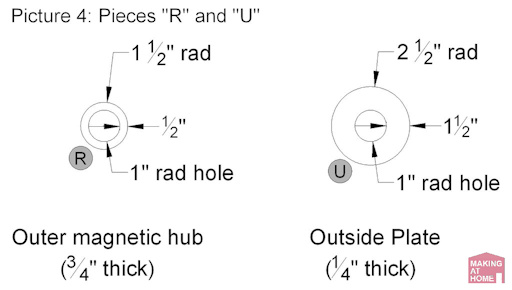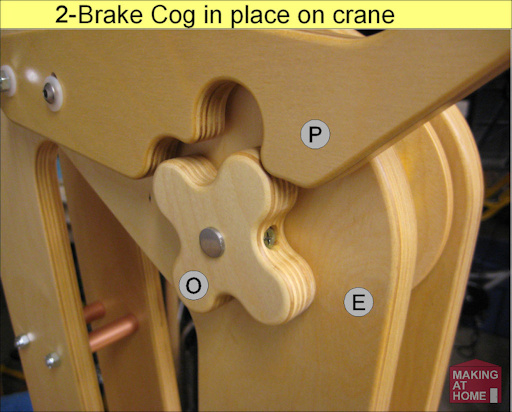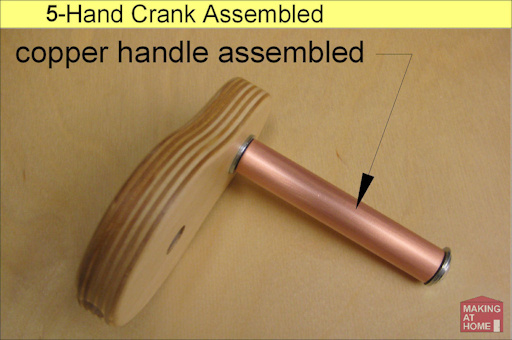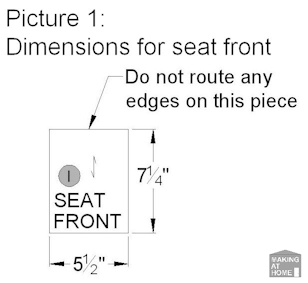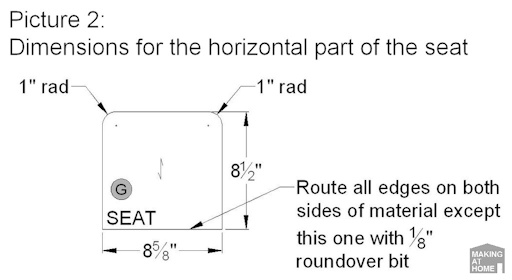The Kid Crane
Video of the Kid Crane in action…
My youngest son on the Kid Crane.
The Kid Crane
I designed and built this toy crane for my youngest son. I call it a toy, but it is really a heavy duty machine for a kid of any age. I designed this crane for my son who was a crane fanatic at the time. It may take some time to build, but the results are worth it. What else are you going to do with your spare time.
The crane is built mostly from wood and uses various screws, nut, bolts, caster wheels, and a variety of other parts.
Step 1: Tools and Materials You Will Need
Materials
This is a fairly long list of materials, but you may be able to substitute use some parts that you already have.
MATERIALS LIST
WOOD
1 - 3/4" x 60" x 60" baltic birch plywood
1 - 1/2" x 8" x 12" baltic birch plywood
1 - 1/4" x 3" x 12" baltic birch plywood
HARDWARE
17 of 1/4" x 4" carriage bolts - home improvement store
1 of 1/4" x 4" carriage bolts - home improvement store
4 of 1/4" x 5" carriage bolts - home improvement store
1 of 1/4" x 6" carriage bolts - home improvement store
10 of 1/4" flat washer - home improvement store
4 of 1/4" flat washer - nylon or plastic - home improvement store
12 of 1/4" lock washer - home improvement store
2 of 1/4" carriage bolt caps - home improvement store
34 o1/4" nyloc nut - Nylon-Insert Locknut 1/4"-20 Screw Size - home improvement store or McMaster (404) 629-6500 http://www.mcmaster.com/ part# 90640A129
12 of 1/4" - 20 x 1-1/4" panhead straight bolt - home improvement store
4 of 1/2" flat washer - home improvement store
1 of 1/4" - 20 x 1-1/2" cap screw (allen wrench or slotted head) - home improvement store
1 of 3/8" x 3-1/2" carriage bolt - threaded on end only - not all-thread Home Depot or other home improvement store
2 of 3/8" flat washer - home improvement store
1 of 3/8" nut - home improvement store
1 of 3/8 nyloc nut - home improvement store
1 of 1/2" x 3 foot long steel rod - home improvement store
1 of 1" x 1/8" x 3 foot aluminum bar stock - home improvement store
10 of 1-5/8" coarse gold #8 deck screw or regular #8 wood screw - home improvement store
5 of 2" coarse gold #8 deck screw or regular #8 wood screw - home improvement store
4 of 1-1/4" #6 pan head wood screws - home improvement store
4 of 1-1/4" (32mm) washer head #2 square drive coarse screws (for pocket holes) - not needed if attaching the seat top by other method - home improvement store
2 of 1-1/4" #8 - 32tpi machine screw (for attaching sprockets to 1/2" rod) - home improvement store
3 of 2" #8 - 32tpi machine screw (for tapped holes in modified caster wheel and attaching sprocket on bike crank) - home improvement store
3 of #8 nyloc nut - home improvement store
1 pk of 1/4'' -20 Threaded Inserts - order 1 pack of 10 - 2 are needed Woodcraft - 800-225-1153 http://www.woodcraft.com part#12K50 $5.99
MISCELLANEOUS
1 pk of 1/2" rare earth magnets - order 1 pack of 10 - 8 are needed - Rockler Woodworking and Hardware - 1-800-279-4441 http://www.rockler.com 30810 $8.29
1 of 1/2" copper pipe x 5-feet long - home improvement store
10 feet of 1/4" nylon rope - home improvement store
1 plastic hook - home improvement store
1 of Steel Ball Bearing, Flanged Double Sealed For 3/8" Shaft Dia, 7/8" Od McMaster - (404) 629-6500. http://www.mcmaster.com/ part# 6384K354
2 of 1/2" inner diameter / 1-1/8" outer diameter roller bearing - for transfer rod McMaster - (404) 629-6500. http://www.mcmaster.com/ part# 60355K46
1 Miscellaneous 1/2" inner diameter shaft lock collar McMaster - (404) 629-6500. http://www.mcmaster.com/ part# 6432K16
1 of 18 tooth #35 sprocket with 7/8" bore diameter - for caster McMaster - (404) 629-6500. http://www.mcmaster.com/ part# 6280K21
2 of 10 tooth #35 sprocket with 1/2" bore diamter - for transfer rod McMaster - (404) 629-6500. http://www.mcmaster.com/ part# 6280K322
1 of 16 tooth #35 sprocket with 1" bore diamter - for foot crank McMaster - (404) 629-6500. http://www.mcmaster.com/ part# 6280K385
1 pk Miscellaneous nylon spacers - 1/4" inner diameter, 1/2" outer diamers, 3/4" long - approximately 26 needed, but come in pack of 100 McMaster - (404) 629-6500. http://www.mcmaster.com/ part# 94639A505
1 of 2-inch diameter smiley face superball - Local Craft Store
PEDALS AND BIKE PARTS
1 ea Pedals Pyramid Barefoot Pedals, 1/2 PN# 41021 BikepartsUSA A Bicycle Inc. - (877)-727-8731 http://www.bikepartsusa.com SKU: 01-117564 $9.99
1 ea Bike Crank Pyramid 3-1/2 PN# 21016 crank BikepartsUSA A Bicycle Inc. - (877)-727-8731 http://www.bikepartsusa.com SKU: 01-97559 $7.29
1 ea Bottom Bracket Pyramid BMX, 1-pc, 24 TPI, BB set PN# 22240 - bottom bracket BikepartsUSA A Bicycle Inc. - (877)-727-8731 http://www.bikepartsusa.com SKU: 01-98783 $5.99
CASTERS
3 of 3" Casters, Non-Locking, Non-Swiveling with 4 Hole Mounting Plate Woodcraft - 800-225-1153 http://www.woodcraft.com part# 141052 $11.50
CHAIN
4 feet of #35 roller chain McMaster - (404) 629-6500. http://www.mcmaster.com/ part# 6261K294
4 of #35 chain connecting link McMaster - (404) 629-6500. http://www.mcmaster.com/ part# 6261K191
2 of #35 chain half connecting link McMaster - (404) 629-6500. http://www.mcmaster.com/ part# 6261K261
All wood pieces were finished with wipe-on polyurethane. It works great and makes touch-ups easy. Make sure to use multiple coats.
Tools
The tools I used on the project were as follows:
Table saw
Band saw
Oscillating spindle and belt sander
Cordless drill
Drill press
Random orbit sander
Router
Router table
Pipe cutter for copper pipe
Hacksaw or cutoff saw
Sanding block
Screwdrivers and wrenches
Not all of the tools in this list are required, but will make the construction much easier.
NOTE: If you plan on using any tool for a project please make sure you are familiar with the tool and all of the dangers associated with it. If you are not familiar with a tool then you should ask someone who is to show you the proper way to use it. A lot of communities have classes at local colleges on the proper use of tools and machinery. There are also local woodworking clubs that offer classes at very reasonable rates for beginners. I highly recommend using these resources for your safety and for the most efficient use of the tool.
SAFETY FIRST
Always wear eye and hearing protection.
Always work safe with the proper safety equipment and guards on your tools.
Step 2: Layout and Rough Cut of Pieces
The first step is to lay out the pieces for the crane on your wood to make sure you have all of the pieces needed.
The pieces have been arranged so that a 5' x 5'x 3/4"sheet of baltic birch plywood can be cut in half and still used for the project. This may make it easier if you don't have a truck to transport the full plywood sheet. Cut the sheet of plywood in half with the grain so the preferred grain direction for the different pieces will work.
A more detailed layout of the crane booms is found on the following pages. I recommend cutting one of the boom pieces out and then using it to cut the matching piece. We will go into this in more detail later.
Lay out all of the pieces on the sheet. Leave 1/2" around all of the pieces except where you use an existing edge of the plywood. Keep all scrap wood for use later.
Label all of the rough cut pieces for ease of identification. Blue painters tape labeled with black marker works great for this. Blue painters tape removes easier and cleaner than most other types of masking tape and holds well to the material.
In the pictures that follow the parts for the crane are identified with a letter in the gray circle.
Step 3: Casters
The crane rotates on three casters. One of the casters must be modified to attach a sprocket to drive the wheel. See picture #1 below.
Take the caster apart as shown in picture #2 below.
Drill two 11/64" diameter holes through the black caster hub. You will be just outside of the silver bearing assembly. See picture #3 below.
Using a tapping drill for a #8 x 32 thread per inch screw drill matching holes in the 18-tooth #35 sprocket. Start the holes on the hub side of the sprocket.
Tap the holes using the tapping bit and "T" handle. Take your time and clean the tapping hole out often. If you break the tapping bit off in the hole you may have to drill new holes offset from the old ones and tap those. See picture #4 below.
Use an air compressor or "canned" air to blow the tapped holes out. Make sure you wear safety glasses while doing this as well as the rest of the time you are working on the crane. Use a #8 x 2" machine screw to attach the caster to the sprocket. Feed the screws through the wheel and then through the hub side of the sprocket. Include a #8 lock washer at the head of the machine screw. The screws should not extend out of the sprocket.
Reassemble the caster as shown in picture #5 below. Replace the original 3/8" diameter bolt with the new 3 1/2" bolt.
See picture #6, #7 and #8 below for the completed assembly.
Attche the casters to the base with 1/4" diameter x 1-1/4" long panhead machine screws. Use a 1/4" lock washer and 1/4" nyloc nut to keep the casters from working loose. See picture #9 below.
Make sure the bolts going through the caster wheels are aligned with the center of the base. This will keep the casters from sliding on the base as they rotate. Think of it as aligning the wheels on a car.
Step 4: Base Construction
Layout the locations for the casters on the base piece using the dimensions in picture #1 below.
Drill a 1/4" diameter hole in the piece to begin with. It is recommended to use the 1/4" hole for cutting the piece to the correct diameter using a router trammel. This is nothing more than a piece of material that turns your router into a compass with a router on the end.
From the center point of the circle draw a line to the right side of the circle and point #1. We will call this the horizontal reference line.
Using a protractor or the measurements below, layout the lines from the center of the circle to points #2 and #3 where the casters are located. See picture #1 below.
Measure 2-3/8" up from the center of the circle to the bottom of 3' long by 1" wide slot with rounded ends. This will be the slot where the chain passes through the circle to drive the caster.
Round the outside top and bottom edges of the circle with a 1/8" radius roundover router bit.
Mark the locations for the caster wheels and drill the mounting holes. Make sure you drill perpendicular to the surface and use a scrap piece of wood as a backer piece so the drill does not tear out material when it passes all the way through the 3/4" plywood.
See Pictures #2 and #3 below.
Step 5: Boom Construction
Two identical pieces are needed for the crane. Once you have cut out one of the boom sides you will use it with a router template cutting bit to cut the matching side.
Use the dimensions below to lay out the outline of the boom. See pictures #1, #2 and #3 below. Make sure you draw everything through picture #3 before you cut out the boom piece.
Drill holes where shown. See picture #2 and #3 below. Use a backing block when drilling to prevent blow-out on the back side of the piece when drilling through. Both sides of the plywood on many of the pieces will be visible when the project is complete.
Use this completed piece to trace the other boom side piece.
Cut to within an 1/8 inch of the traced outline using a bandsaw if possible.
Clamp the two pieces together and use a pattern routing bit to trim the second side piece to an exact match of the other.
A flush cut router bit (guide bearing on the bottom) can be used. See picture #4 below. Just put the template piece on the bottom and make sure the router height is adjusted properly so the guide bearing rides along the edge of the piece you are copying.
Copper pipe pieces are used between the two sides of the boom to separate both sides.
Measure the thickness of 3 pieces of the 3/4-inch stock material you are using to determine the length of the copper pipe needed for the spacers.
Cut 8 pieces of copper this length using a standard pipe cutter available at any hardware store. Make sure you remove the sharp edges on the cut pipe with a file or sandpaper.
Use a very fine sand paper, 300 grit or higher, to sand the pieces of copper pipe. Do not worry about sanding or polishing all of the copper pieces perfectly smooth. Just try to sand them to a uniform finish. Sanding lengthwise is recommended.
Continue using finer grit sandpaper to achieve the finish on the copper pipe that you like.
Stand the pieces on end on a board with screw protruding to spray the pieces with spray lacquer. See picture #5 below.
Coat the copper pieces with several coats of spray lacquer for a lasting shine.
The copper pipe is installed with nylon spacers inside the pipe to limit the movement in any direction. Without the nylon spacers the movement of the copper spacers will scratch the inside faces of the boom. The carriage bolts through the copper pipe are installed with a nylon locking nut on the end. See picture #6 below.
Step 6: Boom Bottom Spacer
Loosely assemble the two sides of the boom with the copper spacers. Two people are recommended for this step as the boom can tip over easily without the circular base attached.
Glue the three "L" pieces and place it between both boom pieces as shown in the picture below. Mark the two holes in piece "L" where the 1/4" carriage bolts will go through the piece from one side of the boom to the other. Drill the 1/4" diameter holes through "L".
See pictures #1, #2 and #3 below.
Step 7: Pedal Crank Assembly
In this step we are going to modify a one-piece kids bicycle crank to accept a #35 sprocket. This will allow you to mount the sprocket in the middle of the crank and hide the sprocket and chain in the center of the crane boom.
Start by removing the stub on the side of the crank. This can be also be done as a later time. See picture #1 below.
Since the center of the one piece crank arm is 0.75" diameter and the threads are approximately 0.865" diameter then we have to create a spacer to fill the gap between the crank and the sprocket inner diameter of 1".
Do this by taking a 1" wide by 1/8" thick aluminum bar and bending it around the center of the crank. Clamp the crank down to the bar stock and bend the bar up and over the center of the crank to create a "U" shape. See picture #2 below.
Make two pieces exactly the same as shown in pictures #3 and #4 below.
Cut the half circle end off of the bent piece with a hack saw. You should end up with two pieces as shown in picture #5 below.
Drill a 3/16" diameter hole through the hub on the #35 16-tooth sprocket.
Slide the sprocket over the end of the one-piece crank to the center of the crank and check that the aluminum spacers you made fit between the sprocket and the crank. See picture #6 below.
Put the sprocket on the crank arm in the boom with the bearings. Line the sprocket teeth up with the opening in the base circle. Mark the hole location on the aluminum spacers and crank and drill a 3/16" hole through the spacers and crank. The spacers should extend out from the sprocket a maximum of 1/16" on the right side of the sprocket as shown in picture #7 below.
Insert a 2-inch long #8 32tpi machine screw through the sprocket, spacers and crank. Secure the screw with a nylon locking nut and cut off the excess screw threads. The final length of the #8 screw should be 1-3/4". See picture #8 below.
Picture #9 shows a side view of the finished crank assembly.
Picture #10 shows the bottom bracket cup set and the pedals.
Step 8: Chain Connection
The power from the pedal crank is sent to the drive caster by the use of a transfer rod. The transfer rod is supported by two identical wooden plates. The transfer rod is a 1/2" steel rod that transfers the rotation of the foot pedals to the caster drive wheel.
Start by making 2 identical pieces for the ends of the transfer rod. See picture #1 below.
Set the bearing in the transfer rod end plates as shown in picture #2.
We start the layout of the pieces by placing a tape line from the axle of the drive caster to the center of the base as shown in picture #3. This will be the layout line used to set the transfer rod end plates and the rest of the components for the transfer rod.
Set a second piece of tape parallel with the first with one edge intersecting the center of the chain hole in the base as shown in picture #4. The transfer rod should be placed directly over this tape edge to keep all parts in alignment.
Line up the sprocket on the transfer rod with the sprocket on the drive caster as shown in picture 5. This position sets the location of the end plat for this end of the transfer rod.
Line up the other sprocket with the opening in the base as shown in picture #6.
Both sprockets are attached to the 1/2" rod with a 1-1/4" #8 32tpi machine screw and a nylon lock nut. You will need to drill through the 1/2" rod once you have the sprocket locations set. If you can't find a 1-1/4" #8 machine screw then use a 2" long #8 machine screw and cut it to length after installing the sprockets on the transfer rod.
Picture #8 shows the chain installed on the drive caster.
Install the chain from the sprocket on the foot crank to the transfer bar on the bottom of the crane as shown in picture #9.
Install cover plate "Y" over the upper sprocket and chain. Pre-drill holes in assembly "JKJ" before installing screws.
Use 4 #6 panhead wood screws to attach the cover plate as shown in the picture #11
See picture #12 for the dimensions and hole locations for the cover plate.
Step 9: Drum Assemblies
The crane has two drum assemblies to build. The large drum is made up of two parts - the inner and outer drums. The inner drum is connected to the 1/2" steel shaft that is turned by the hand crank. The inner drum drives the outer drum using 1/2" diameter rare earth magnets. This effectively creates a slip clutch for the drum and helps prevent heavy items from being suspended from the crane hook. This will minimize the chance of the crane being tipped over if the child gets off of the crane with a heavy load on the hook.
The inner drum is built from a piece of 1/4" and 3/4" baltic birch at 15/16" diameter. These are glued together to form a drum that is 1" thick.
Drill 1/2-inch diameter maget holes 9/16" from center of piece "Q" and "S" as shown in the picture upper right.
If you do not want the magnet hub option in your crane then omit pieces "R", "S", "U" and "X" and make two of piece "Q" and "T".
See pictures #1 through #4 below for dimensions and material thickness.
See pictures #5 and #6 for pictures of the drum pieces.
Four magnet in each side of the hub can be used for added holding power and is recommended. See picture #7.
Glue the pieces together as shown in picture #8 below.
Glue piece "U" on to the assembly from the previous step to complete the hub. See picture #9 below.
Drill a 3/8" diameter hole through the large hub at 5/16" from the inside of piece "U". Drill through the hub directly towards the center. Insert the inner magnetic hub and make the location of the hole. See picture #10 below.
Countersink a 3/8" diameter hole into piece "S" as shown in picture #11 below. Pre-drill a 1/8" diameter hole through piece "S".
The finished hub shown in picture #12.
The small drum or hub is assembled from 1/4" thick and 1/2" thick baltic birch plywood. Cut two circles that are 1/4" thick and have an outside diameter of 1-3/4" with a center hole of 1/4" diameter. Cut 1 circle that is 1/2" thick and has an outside diameter of 1-1/4" with a center hole of 1/4" diameter. See picture #13.
Glue the three circles together with the larger diameter circles on the outside to form the hub as shown in picture #12. Use a carriage bolt or a 1/4" diameter dowel to keep the circles aligned when gluing them together.
Step 10: Brake Cog
Using the dimensions in picture #1 below, cut the brake cog out of a 3/4" thick piece of baltic birch. Use a 3/4" diameter brad point or forsner bit to drill the inside radii first Then use a band saw to remove the outside radius waste. Finally, use a spindle sander to smooth the edges to the template below.
Round all edges on both side with a 1/8" roundover router bit.
Step 11: Brake Handle
See the picture below for the dimensions for the brake handle. Remember that you can view the image at full size by clicking on the "i" in the top left of the picture and selecting the scale you want. This piece is made from 3/4-inch thick material.
Step 12: Hand Crank
This is the hand crank for the hoist on the crane. See the pictures #1 and #2 below for more details on this piece.
See picture #3 for the finished piece.
Cut one of the nylon spacers so the carriage bolt screws into the 1/4" insert in piece "N" and is flush with the back side of the piece. See picture #4 below.
Cut the copper piece to length 1/32" less than the space between the washers. This will allow it to spin freely on the nylon spacers. See picture #5 below.
Another view of the handle assembly is shown in picture 6.
Step 13: Hand Crank, Drum, and Brake Handle Assemble
Install the magnetic hub on the 1/2" diameter steel rod with a 1/2" flat washer on both sides to keep it centered between the boom side pieces. Add a 1/2" flat washer
to the steel rod on the outside between the side of the boom and the brake cog.
To make the magnetic hub act like a solid hub then back the set screw out until it is extended into the outer magnetic hub, but still through the 1/2" steel rod. See picture #1 below.
Install the brake cog as shown in the picture below using a 1-5/8" gold coarse set screw. The 1/2" steel rod will need to be cut off outside of the brake cog "O" and on the other side of the crane with the crank handle "N". It is recommended to do this after the brake cog and crank handle are installed. See picture #2 below.
Install the brake handle "P" on the end of the 5" carriage bolt as shown in picture #3 below. Include a 1/4" diameter nylon or plastic flat washer between the brake handle and boom. See picture #5. Add another 1/4" nylon flat washer on the outside of the brake handle. Finish by installing a 1/4" nylon locking nut and a 1/4" cap as shown in picture #6 below.
Let the brake handle "P" rest on the brake cog "O" as shown in picture #4 below. Mark the hole for the 1/4" insert in boom "E" at the top of the slot in the brake handle while it is in this "down" position.
Lift the brake handle out of the way and drill a 3/8" diameter hole for the 1/4" insert. The hole should only be 1/2" deep. Be careful not to drill the hole all the way through the boom side.
Lower the brake handle and Install the 1/4" - 20 x 1-1/2" cap screw as shown in the picture upper right.
Use a 2" gold coarse wood screw to install the hand crank. Make sure to insert a 1/2" flat washer between the hand crank and the boom on the 1/2" steel rod. See picture #7.
Step 14: Seat
Cut all 5 seat pieces to size as shown below. The seat top is held in place by 4 pocket screws. Use an alternate attachment method if you do not have access to a pocket screw jig.
See pictures #1 through #5 for dimensions and hole locations for the seat pieces.
For pocket holes use 1-1/4" (32mm) washer head #2 square drive coarse screws for baltic birch. Follow the recommended materials recommendation for the type of material you are using for the seat.
Drill pocket holes for the seat top and the holes to attach the seat back to the seat sides and the seat sides to the seat front. See picture #6.
Fully assemble the seat as shown in picture #7. Wait until the boom has been fully installed before attaching the horizontal seat piece G. Building the rest of the crane will be easier with it uninstalled.
Using painters tape mark the sides on the seat using the center reference mark for the crane seat. Next place the assembled seat between the tape marks and position it so the seat back does not hang over the routered edge of the base circle. Place a line of tape in front and behind the seat to mark the full outline of the seat. Mark and drill the holes to attached the seat to the base circle as shown in picture #8 below. The holes will need to be drilled 3/8" in from the painters tape in order to be in the center of the seat sides and seat back.
Clamp the seat down on the base circle using the tape alignment as shown in picture #9. Drill and countersink holes for 2" long #8 gold coarse deck screws to attach the seat to the base.
Step 15: Rope and Hook
Find a hook that you would like to use for the crane. If using a bungee cord hook make sure that the bungee cord it has been designed for is approximately 1/4" diameter. See picture #1 below.
We modified the hook we used as shown in picture #2 so kids could hook onto things more easily.
Use a 1/4" rope for the crane. For a construction theme we used this black and yellow rope shown in picture #3..
Slide the ball on the end of the rope and then the hook. Tie a knot in the end of the rope to keep it from pulling through the hook. Knots in some types of rope can sometimes pull out or fray apart. You can lightly melt the end of the rope or coat it with epoxy to help prevent this from happening. See picture #4.
Use a 3/8" brad point bit to drill a hole through the 1-1/2" diameter superball. Lightly sandwich the ball between 2 boards on a drill press. Pre-drill the hole in the top board and feed the drill slowly. See picture #4 for the superball in place on the rope.
Coat the last 3/4" of the rope with a thick layer of epoxy as shown in picture #6. The epoxy helps hold the rope in the hole on the drum and keeps the ends from fraying. A little light sanding will take care of thick spots on the epoxy is too thick for the hole in the drum.
That's it! After the epoxy cures you are ready to put the rope on the crane and let the kids have some fun. Since this is built with heavy duty parts even the adults can have fun riding on this toy.

